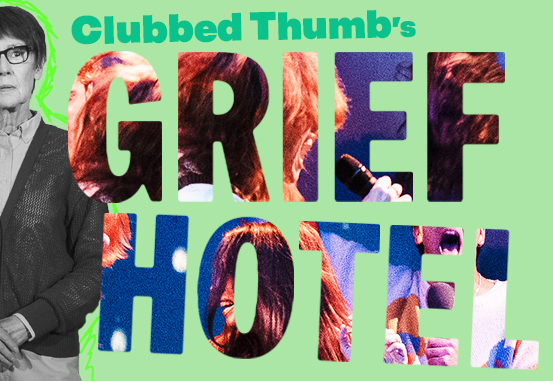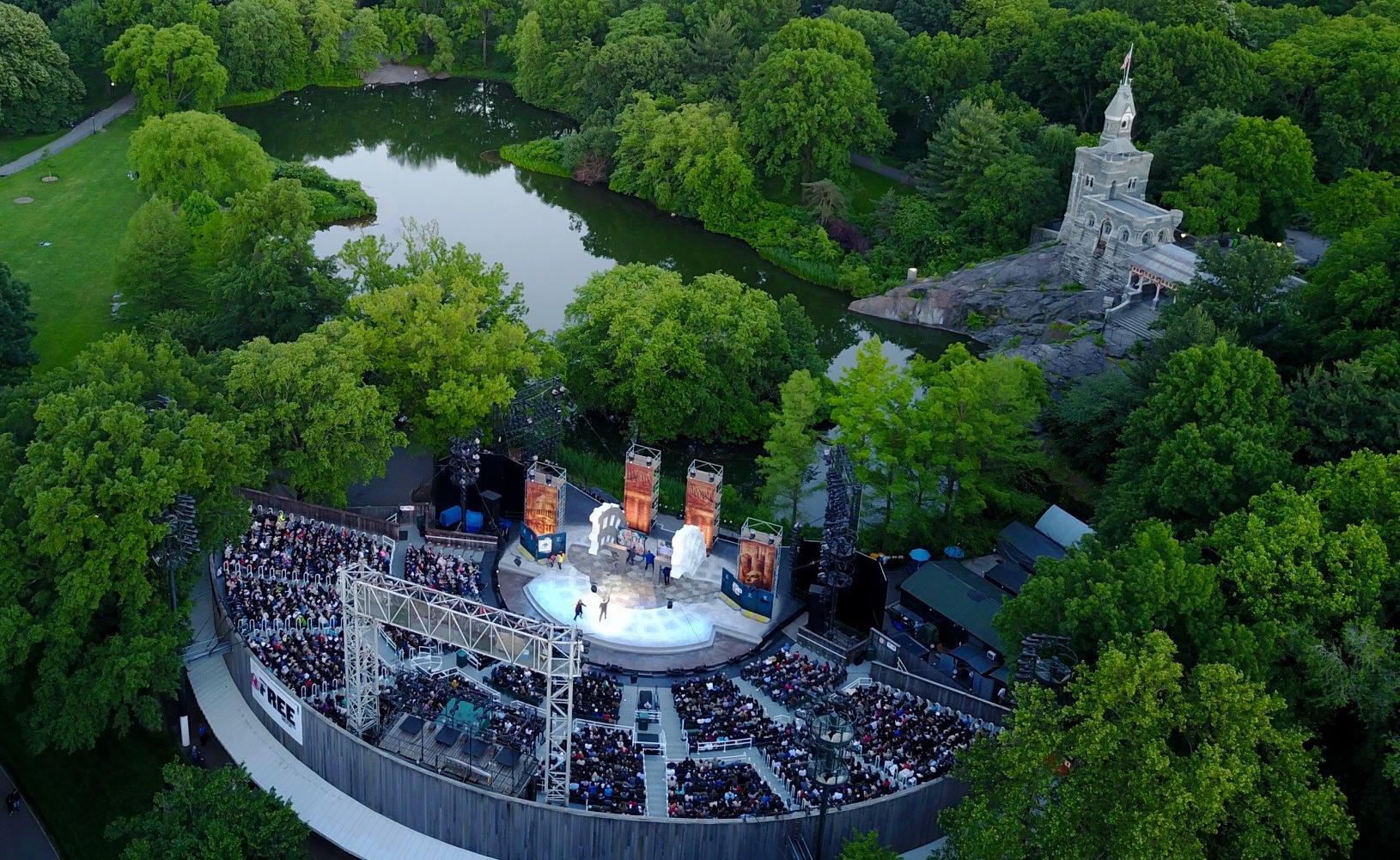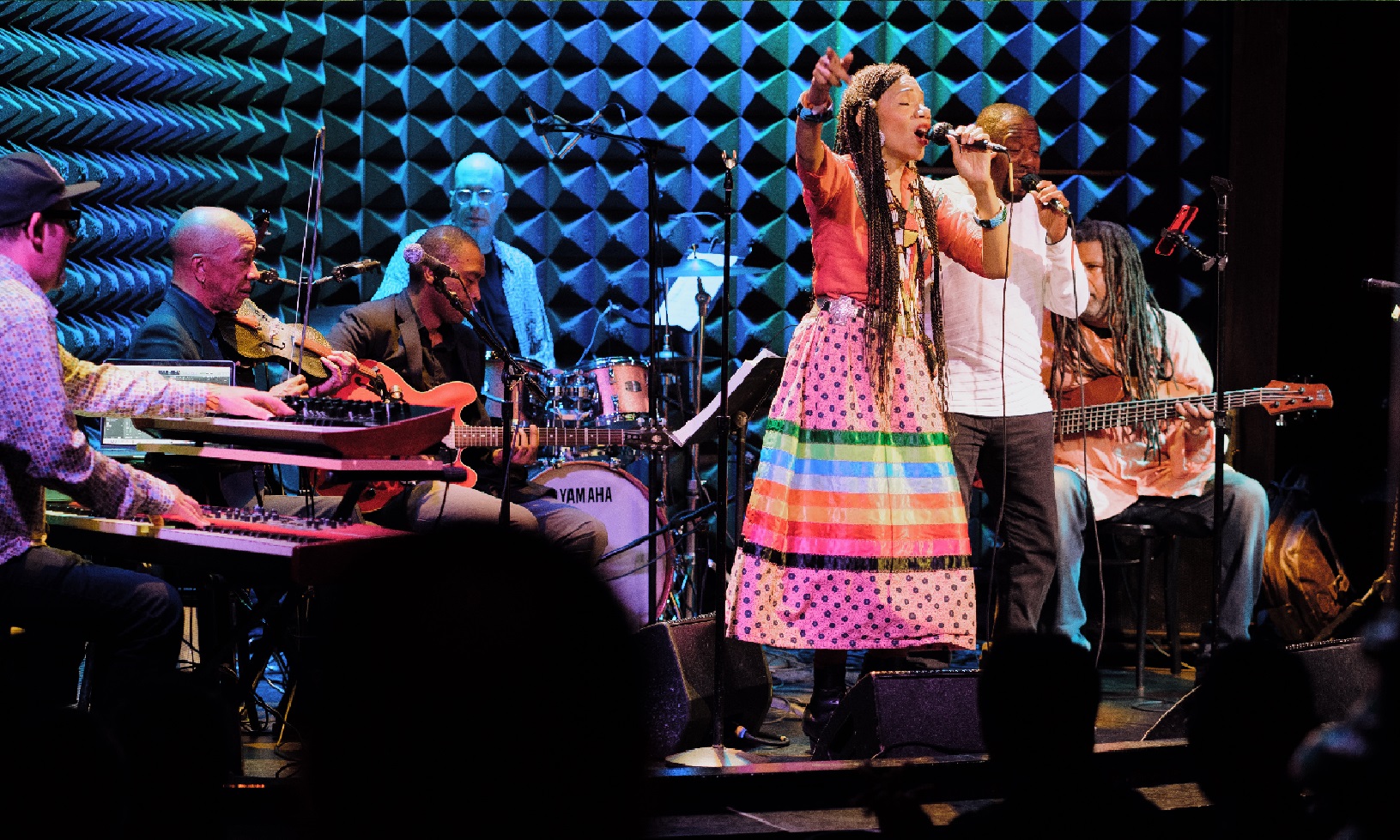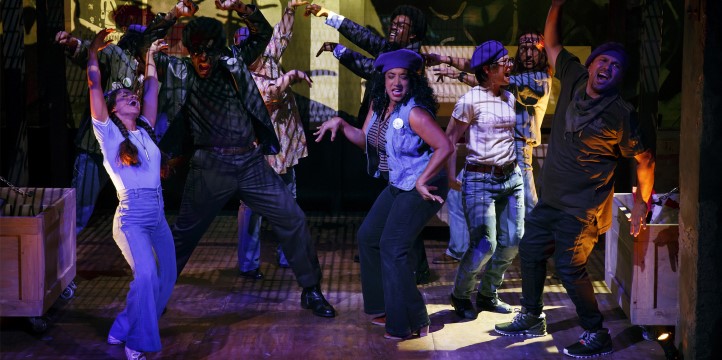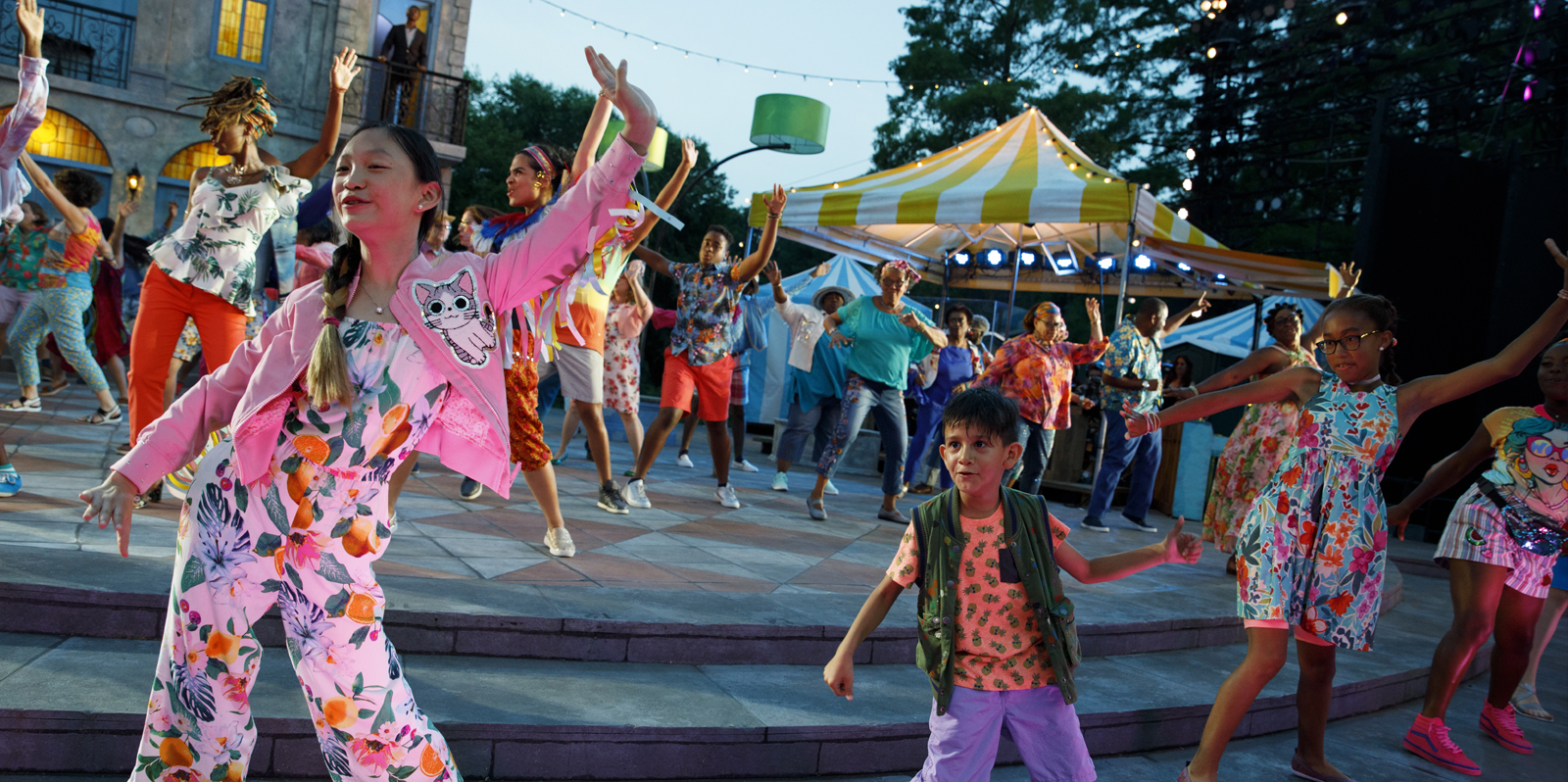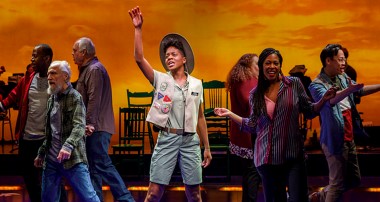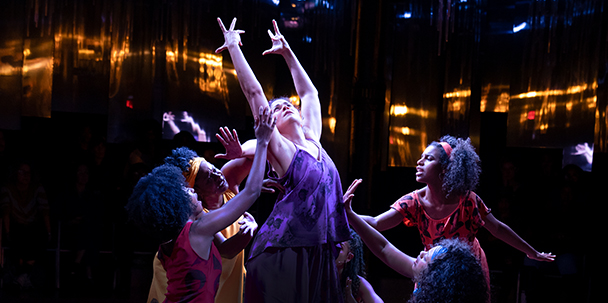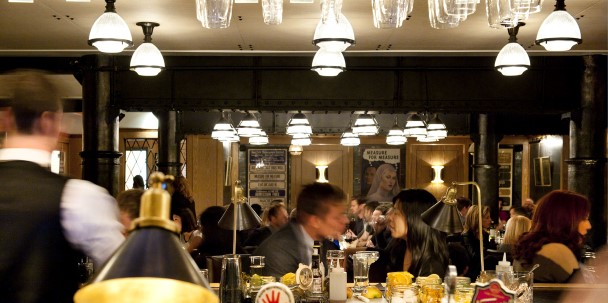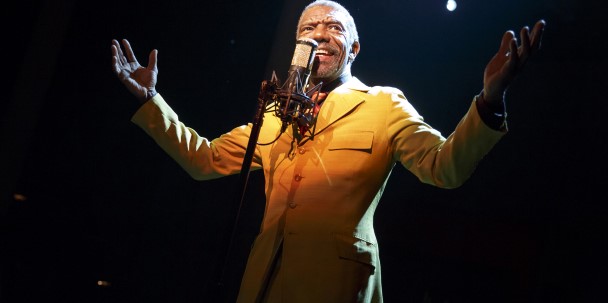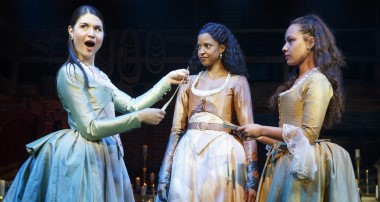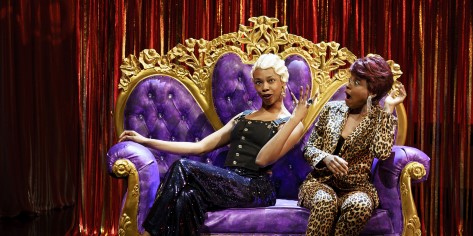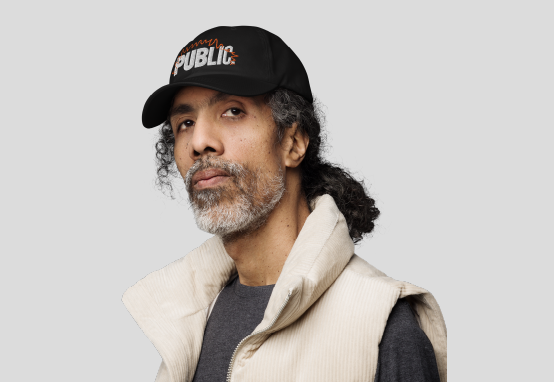Reynaldi Lindner Lolong: In 1954, Joe Papp had a brilliant idea to bring free productions of Shakespeare to the people of New York. He started on the Lower East Side, toured parks across the city, and ended up in Central Park and on Aster Place.
Drew Broussard: But that was just the beginning. What began as summertime Shakespeare in neighborhood parks has since blossomed into a year-round hub of culture, with new plays and musicals—
RLL: experimental work—
DB: live music—
RLL: international performance art—
DB: cabaret—
RLL: conversations and civic dialogue—
DB: community engagement—
RLL: and of course, Shakespeare.
DB: Through it all, the impulse has remained the same: that culture belongs to everyone, and that theatre should be of, by, and for all people. Welcome to Public Square, a podcast from The Public Theater.
DB: Hi, I’m Drew Broussard, from the artistic staff.
RLL: I’m Reynaldi Lindner Lolong, from the marketing/communications team.
DB: In October 1988, Joe’s Pub opened on the north side of The Public Theater’s Lafayette Street home. Since then, 2-3 shows a night for somewhere between 362-364 days a year, they have been churning out incredible performances: live music, performance art, theatre; you name it, it has happened in Joe’s Pub. In 2011, the Pub was renovated, and in 2013 Rolling Stone called it “one of the ten best clubs in America.” So for this episode, we’re going to take you behind the scenes in the Pub and in its sister venue The Library, upstairs at The Public. We’ll talk to the folks who make the magic happen night after night, we’ll hear some music, and a couple of special behind-the-scenes looks.
IK: Hi, I’m Isabel Kim, and I am the Programming and Admin Manager at Joe’s Pub.
AK: And I’m Alex Knowlton. I’m the Director of Joe’s Pub.
RLL: And so I guess, from each of you in your own words, for someone who’s never been here, what is Joe’s Pub?
AK: Well—
[laughter]
AK: Ummm … Joe’s Pub is in its simple, most basic setting, is a physical space that is the cabaret club within The Public Theater. Joe’s Pub is a 184-seat performance venue. That’s kind of the simplest way to say it, but Joe’s Pub is also kind of an artistic community, it’s an artistic aesthetic, I feel like it’s a home base, it’s a safe space, it’s a dangerous space. It kind of means a lot of things to a lot of different people.
IK: My first experience at Joe’s Pub was as a performer, so just walking in, just being in that space was so—like, even though it’s a small, intimate space, it’s so impressive and beautiful.
RLL: Joe’s Pub’s op—is it three—do you have performances literally every day this year? I remember when I started, it was like, “We’re open 363 days!” Then it became 364 days. Are we up to 365?
AK: Actually, I’m going to take this opportunity to apologize to the box office and the front of house staff. We just confirmed two shows on December 24th, so I think we’ll be open—
IK [at the same time]: Sorry.
AK: —I think, 361 days this year.
IK: Yeah, something like that.
AK [overlapping]: There’s some—there’s a couple holidays we take off, but mostly we’re here.
IK: Yeah.
RLL: Okay. And so like, I know that’s like, 2-3 performances a day, nearly 800 performances a year. And I think one of the things that always struck me about Joe’s Pub is like, you can see a Sondheim birthday tribute at 7pm, you can see Justin Vivian Bond at 9pm, Martha Redbone at midnight. There’s such an amazing variety to it. How do you wrap your brains around programming this space?
IK: [laughs] Uh, yeah, 800 is a very large number, but actually when we get down to it, like with all the artists that we work with, sometimes it feels like we don’t have enough slots. It’s kind of crazy.
AK: Mhmmm. It’s absolutely true.
IK: Yeah!
AK: Yeah.
IK: There’s just so much good stuff out there that it’s actually not as hard as you might think.
AK: And we have—we have the luxury of—of twenty years of history and all of the artists that have come before that want to come back, and want to bring their friends and performers and collaborators and colleagues, and so a lot of what we do is balance in playing defense for the calendar and trying to hold space that isn’t just gobbled up, and try to build in some room for ourselves to be responsive and a little more, um, I don’t want to say last-minute but, a little more responsive and timely, and to be able to kind of give somebody a one-off in the sort of last minute.
IK: Mhmm. Yeah. There are times when like, someone will cancel and we’re like so relieved. We’re like, “Oh my gosh!”
AK [overlapping]: “Oh my god!”
IK: “An opening!”
AK: “A seven o’clock in November? How fun!” And then it’s up to us to figure out what puzzle piece makes the most sense in that week and that month. And we’re so often in very long-term conversations with artists, we’re planning stuff six months, a year, eighteen months out, and so to have something fall in our laps two months out? We’re like, “Oh my god! I just saw so-and-so at Rockwood. Let’s see if they want to do something.” Or just like, “Oh my god, this tour is coming through and it just shifted gears and it’s gonna be in six weeks.” And sometimes we can just like, pick stuff up that’s exciting.
BN: I’m Becca Niemeyer, the Director of Individual Giving. We went to the archives to bring you a review from The New York Times of a now-legendary singer’s first performance in Joe’s Pub.
Adele, a 19-year-old singer-songwriter from London, presented two distinct personalities on Monday night at Joe’s Pub. On one hand she was the self-assured performer whose debut album, “19,” recently topped the British pop charts in its opening week. On the other hand she was a jittery teenager playing her first show in the United States, with a head cold.
“Forgive me if I start coughing up or something during a song,” she said on taking the stage. Then she chortled in recognition of her own breach of concert etiquette.
This disjunctive back-and-forth seemed faintly calculating, insulation against any charge of unseemly pretension. It also felt a bit familiar. Adele, whose full name is Adele Laurie Blue Adkins, is the latest in a line of professionally impudent young female singers to emerge from the BRIT School, a performing-arts high school in London supported by the British Record Industry Trust. Her close predecessors include Kate Nash, Lily Allen and the most gifted and notorious of the bunch, Amy Winehouse.
Late last year the mainstream British press hailed Adele as “the new Amy Winehouse,” a facile yet complicated bit of praise. Onstage Adele mentioned Ms. Winehouse only in passing, but right before the song that most evoked her: “Right as Rain,” a pensive and indignant breakup ditty with a shamelessly retro-soul sound.
“There ain’t no room in my bed, as far as I’m concerned,” she belted in the chorus, “So wipe that dirty smile off.” For that moment the comparison seemed justified, though it did Adele no favors.
Elsewhere in the show, performing simply with an acoustic guitar or no more than two accompanists (the guitarist Ben Thomas and the pianist Steve Holness), Adele suggested an overqualified coffeehouse act rather than a budding pop star. She trusted the bigness and flexibility of her voice, which wasn’t noticeably hampered by her nasal congestion.
Soul is her base-line style as a singer, but she doesn’t deploy many melismatic runs, preferring a simple fillip or shudder. She makes expressive use of dynamics: hitting a note strong and then drawing it back, or inflating a soft purr into a siren call. Vibrato is a reliable mechanism for her. And she’s liberal with intonation: on “First Love,” a music-box waltz, she sang the plea “forgive me” as “foh-WAH-give me.”
Adele drew all the songs in the set from “19,” released in Britain on XL and due out in the United States on Columbia in the spring. (Her cover of Bob Dylan’s “Make You Feel My Love” appears on the album; “That’s It, I Quit, I’m Movin’ On,” a hit for Sam Cooke, is available only on the Japanese version of the album.) Her originals dealt extensively with love and restlessness and, in one case, the gritty charms of her North London neighborhood. As songs, they were poised but callow.
In some ways that combination suits an artist in Adele’s position. “My Same,” inspired by a close friend, even sounded like something she might have dashed off in school. The duality of “19” may work for only so long, though; Adele hits 20 in May.
DB: How much curation are you doing versus people who are dropping in and coming to you and asking to play here? What is—what does it look like, putting that calendar together?
AK: Well that’s the secret sauce, Drew.
DB [muffled]: That’s why we have the podcast!
AK: I know, but if I tell you—
[laughter]
AK: Um, most of the programming that we’re doing are long conversations. I kind of think of it—and this is not scientific or mathematical at all—I kind of think of it in three segments. There’s ⅓ of the artists that are playing at Joe’s Pub are artists on tour that are based elsewhere in the country or the world who have a team, they have a record label or a booking agent, they’re coming through, they’ve played New Haven yesterday, they’ll be in Philly tomorrow, and they’re playing New York, and we may never see them again. And so we get one night with them, which is great. And then the other third are kind of like, the larger New York scene.
So these are artists who are playing at 54 Below, they’re playing at Rockwood, they’re playing the Bowery, and I think of—I encourage them to think of Joe’s Pub as a tool in their tool box. When the time is right, when the show feels right, if this is a rock band that has an acoustic duo thing they wanna do, if this is a smaller group that has a record launch, it can be a step up or a pivot over or just, like, the right key for the lock. Uh, and then the other third is the family, and these are people that we’re always talking to, that we see in the audience all the time, that are special guests on other people’s shows, and it’s just kind of like, this ebb and flow of like, “That was fun! Let’s do that again”—“Okay, great: when?” And then we just—we just do it. We’re kind of always talking to a large section of folks.
IK: More the—the more curated stuff is outside of here? So like, there’s the Astor Live series, so—
AK: That’s right.
IK: Make Music New York, um, what is it? Friday Night Cabaret, and Aster Live, which happens outside at the Astor Plaza. Those are much more curated.
RLL: So I think what a lot of our listeners probably don’t realize is that Joe’s Pub has a really robust series of artist development programs, things like the Working Group, the Vanguard Residency. Can you talk a little bit about those, and just kind of the different ways that, more than just a performance venue, Joe’s Pub is also very much a program at The Public that really puts a lot of support behind artists really at all levels of their career?
IK: We love the Joe’s Pub Working Group. Um, we select—we do an application for artists to be a part of this, and then in the end, we select five artists to be a part of the Working Group. We love it; it gets us out of the office and we sit down with these five artists for two hours every month, um, and it’s a great group. It’s interesting—it’s not emerging artists and it’s also not, y’know, celebrity artists; they’re a kind of, um—they’re already pretty established, they’re pretty savvy with their careers and what they need to do.
And so we just try to use this, the Working Group, as a way for them to kind of talk to each other, and also just to provide them with some resources that they may not have. We’ll do panels with different presenters from across the city, or maybe a little outside of the city, and it’s a great way for them to meet people like, y’know, the programmers for Celebrate Brooklyn, or um, someone who wants to do an interview with them on a well-known podcast or radio program.
And we’ll also try to provide resources—you know, like, if they wanted a great video for, you know, a grant application, we can do that for them, like provide a really great quality and edited video for them, which might cost them like a thousand dollars or more if they hired someone to do it, but I mean, that’s something we can do for them. It’s like a weird put-together family, ‘cause they’re all very different; like this—the current class, it’s a comedian and a jazz musician and singer/songwriter, theatre people, so it’s kind of weird, but they—there’s also so much overlap with the things that they’re dealing with, the struggle that they’re dealing with. So it’s a great, weird family for them.
[chuckles]
IK: And it’s really cool ‘cause they’ll—they’re all going to each other’s shows and supporting each other, so that’s really, really great.
AK: And the Working Group is kind of our—our response and contribution to the other what I’ll call WGs in the building; there’s the Emerging Writers Group, and the Devised Theater Working Group, um, and it felt like our kind of opportunity to engage with artists in a similar sort of longitudinal way. Yeah. And then, New York Voices is our commission program where we’re working with primarily musicians who naturally have a sort of narrative to their work, as an opportunity to introduce them to the world of the theatre, where there are structures and resources available that they may not think are available to them, um, and to be able to tell musicians, like, “No, you—there are ways and funding sources and structures in place for you to put a band together and rehearse for a week and then, uh, invite industry to come see it.
Like, there’s a thing that exists for that, and there’s funding and there’s residencies and all of these other things that musicians have been told over centuries that their music is for hire and it’s a commercial product and if they’re good enough, they’ll get a record deal, and then they’ll be rich and famous, and then the bottom fell out of the record industry and uhh, it’s like, “Oh, shit. Uhhh, well that didn’t work. I guess we’ll have to pivot.” And so that’s why we’ve seen the rise of crowdfunding, which is kind of a direct patron program, which is kind of back to the beginning with composers and musicians, and also tapping into the really established, you know, philanthropic system, and the nonprofit structural system of theatre.
And then The Vanguard! Vanguard is our newest program. The Vanguard Residency, in a word, is really, um, our attempt to acknowledge the kind of massive contributions that musicians, singular musicians, have made to the cultural landscape of America and the globe through their music, particularly those who in their success and in their work, create and develop a community around them and with them, and bring up all boats as they rise.
Uh, and so our first Vanguard was Nona Hendyx, who is kind of a never-ending inspiration, whose work in mathematics and robotics and music and production and queer libration, and—kind of, you name it, and she has been there—um, who was an incredible kind of first Vanguard Resident to work with. And this year we have Judy Collins in residence, who similarly has been a prolific activist and has used her music as a voice for change over her very, very long and impressive career. So it’s been a cool way to get to know artists on a really, really deep level, and kind of hear who excites them, and give them a curational opportunity to kind of introduce us to new artists and give stage to them.
DB: Mwenso and the Shakes are a unique troupe of global artists who present music that merges the highest form of entertainment and artistry, while commanding a formidable timeline of jazz and blues expression through African and Afro-American music. They have a new record out called Emergence [The Process of Coming Into Being] and here, from that record, is “No Regrets.”
[musical selection plays]
DB: Emergence [The Process of Coming Into Being] is available now; it’s the debut album from Mwenso and the Shakes, and you can see them on tour around the country this fall and, before long, back in Joe’s Pub.
RLL: Could either of you share just your most memorable experience of a Joe’s Pub performance? And I don’t know if you’re like, allowed to pick favorites, or say that you love all the experiences equally.
[laughter]
IK: I love Shaina Taub; her music is just so good, without any gimmicks or like, being over-the-top, just really good music. Of course, Bridget Everett. One of my favorite, favorite moments here is actually bringing my friends to her show. Some of them knew her, some didn’t, and I was just like, “Hey, Nicole, this is just like, a mellow singer-songwriter.”
[laughter]
IK: “We’re gonna have a good time—we’re gonna have dinner; it will be a nice concert for you.” And then—[laughs] they saw what it really was, and we were also like, in the splash zone, so—
[laughter]
IK: Yeah, that was a great moment for me.
RLL: I feel like everyone has a “brought a friend to Bridgett Everett” story.
IK: I love those stories.
AK: She’s really good for what ails ya.
RLL: So, we always like to end with like, some kind of takeaway for the listener. Um, so imagine you’ve been listening to this conversation, and you’re like, “Oh! Joe’s Pub, that sounds awesome, I wanna give that a try.” You look at the listing of eight hundred possible shows you could see. What would you recommend for someone who wants to try something new, might be a little scared to—like how do you—do you just dive in? Do you close your eyes and point?
IK: I mean, yeah, I think you could probably just pick and—like, just point somewhere, and y-you probably won’t be disappointed, but also just like, write us or like, call the call center.
AK [overlapping]: Yeah, right.
IK: They’re also like, really great about like, pointing you the right way if you say, “Oh, I like this; I don’t like this.”
AK: Yeah, and go outside your genres. If you’ve never seen, like, a comedy show, go s—like, pick a comedy tag. Like, go pick some—go, go pick an artist who is singing or performing in a style or a music or a language that you’re not familiar with, and just, like, come hang out with us, and see what you think.
IK: Or come on a night where you can watch both shows that night, ‘cause you’ll probably get something very different.
AK: The double-header is always a bit jarring.
IK: Yeah.
[laughter]
RLL: You should have like, a double-header pass.
IK: Ohhhh.
AK: That would be cool.
RLL: So you’ll just, like, stay all night.
IK: Yeah.
AK: And just head up to The Library for some soft-serve in between.
RLL: Yes. Yes.
DB: Upstairs at The Public Theater, on the Levin Mezzanine, is one of my favorite parts of The Public. It is The Library, our in-house restaurant and bar, and I am here with our senior mixologist, Shannon Beck. She is gonna make us some drinks!
SB: All right, awesome! So the first drink I’ll make you for today is the De La Lafayette. So, when I created this drink, I was thinking of making a drink that could be our house Manhattan-style cocktail, hence De La Lafayette, because The Public Theater is on Lafayette. So, first I’m adding 2oz of Four Roses Bourbon, which is the basis of—of any good Manhattan. Then I’m gonna add about ¾ of Dolan Rouge, which is a type of sweet vermouth; obviously I’m keeping this in the French family. And then I’m gonna add a liqueur called Benedictine, which is another French-style liqueur. I’m gonna finish that with a dropper of rose water, give it a little floral aspect, and just a couple of dashes of orange bitters. We’re gonna fill our mixing glass with ice, sir it up ‘til it’s diluted a little bit. Every good cocktail has some component of water added to it; in this case it’s coming from ice. Stir that up real nice, and we’re gonna strain that into our coupe martini glass. And that is going to be garnished with a fresh orange twist. And voila! De La Lafayette.
DB: Nice. This is one of my favorite cocktails at the bar. Thank you.
SB: You got it. And then the second cocktail I’m gonna walk you through is a house favorite here at The Public Theater; ask anybody that stops by, uh, our new menu, and their favorite is the Hazel’s Tea. So I’m gonna do another four ounces of that Two Roses yellow: again, a really great staple bourbon that tastes great with pretty much anything that you put it in. I’m gonna do 3oz of lemon juice, little citrus aspect to it. We’re gonna do a half ounce of Italicus, which is an Italian liqueur from bergamot, which is the citrus used to make Earl Grey. We’re gonna do a quarter ounce of honey syrup, and then finish it off with a touch of peach, two dashes of cardamom bitters, and we’re all set to shake! So I’m gonna fill my shaker tin with ice, fill my glass with ice, and shake it up. [sound of shaking] Great! So I’m gonna strain this into my glass. And very last, but not least, I’m gonna express mint and garnish this beauty. There you have it: Hazel’s Tea.
DB: That is delicious-looking. Um, cheers!
SB: Cheers.
DB: Thanks!
SB: Thank you.
DB: Bye!
DB: All right. I am upstairs in one of the Joe’s Pub dressing rooms, and I’m here with Jessie Moore from the Pub team. Jessie, introduce yourself.
SB: Okay. Thanks, Drew. I’m Jessie Moore; I am the Artist Relations and Operations Manager at Joe’s Pub.
DB: As we’ve been saying to members of the Public family who we have on for this segment: what do people think your job is, what do you tell people that your job is, and what is it that you actually do?
SB: I’m not—I’m not sure what people think I do?
DB: [laughs]
SB: And I think that gets me in trouble sometimes, since I started with The Public in 2012, working the front desk. And so people have seen my face around this building a lot, working in a variety of different departments, so I think that’s what people think I do: a little bit of everything. What I do do is I do work specifically at Joe’s Pub. Like, my title says Artist Relations and Operations; there’s a lot of hats that I tend to wear. So that covers company management a little bit, with like, artist handling and drafting up contracts for them, but then also making sure Joe’s Pub executes what we say we do in those contracts when that artist actually gets here.
DB: Cool.
SB: And then on the Operations standpoint, that’s kind of like making sure our room is up and functioning, and serving as the point/middle person/liaison between Joe’s Pub and the Operations department within The Public Theater. So, AC issues, HVAC, the doors won’t open, whatever the case may be. But, um….
DB: You’ve hung out at The Public for quite some time.
SB: Yeah.
DB: What—what led you to the Pub, specifically?
SB: Um, it might have been an accident? It—because, um, when I first came into the building I was coming in to work the front desk from 3:00-11:00, because the person who was working the front desk was on leave. So it was in this building that I kind of, I started realizing that there’s more to theatre, there’s more to the arts than just performing. And I got to see that just by working the front desk, and then I kind of wiggled my way in and stuck around. It’s kind of—it’s kind of messy. My journey in here has been a little messy, but that’s good, because the arts should be a little spontaneous, and my journey has definitely been spontaneous.
DB: Cool.
SB: If that makes sense.
DB: Absolutely.
SB: Yeah.
DB: So my last question for you is, what advice you might give to somebody who is out there who is kind of doing a bunch of different things and—and wants to do something like you, or who is out there following the path that’s laid out before them in some ways?
SB: Yeah, um, don’t be afraid of networking—that definitely helped me get to where I am—and not being afraid to introduce yourself. And once you know what you're passionate about or what you want to be doing, it’s okay to shout that from the rooftops, because you might find somebody who needs—who needs that.
DB: Yes, that’s good advice for everybody, I think.
SB: Yeah.
DB: That’s it for this episode. Thanks so much for listening. Thanks to Alex Knowlton, Isabel Kim, Jessie Moore, Becca Niemeyer, Shannon Beck, Mwenso and the Shakes, and the staffs of Joe’s Pub and The Library at The Public. Music for this episode was by Michael Friedman, audio engineering by Dani Lencioni.

